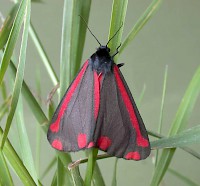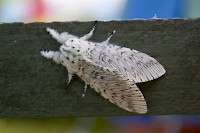Have you found an interesting looking moth or caterpillar and don't know where to start?
I receive quite a number of emails from people who have, but who find searching through the website rather daunting and difficult. I hope this page will help.
Listed below in order of frequency are the most popular ID requests I've had since starting this website. This should give you a starting point at least.
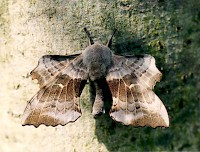
No.1 Poplar Hawk-moth
This should be called the "Popular Hawk-moth"! - it's the most frequently requested identification I get. Large, peculiarly shaped and not easily disturbed.
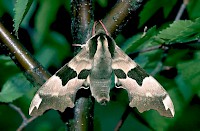
No.2 Lime Hawk-moth
Often described as camouflaged - green and brown, or sometimes just shades of brown, often found in suburban areas. Around 2 or 3 inches wingspan.
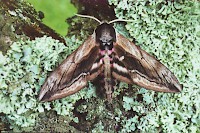
No.3 Privet Hawk-moth
Black and greyish-buff, with a 4 or 5 inch wingspan and 'concorde' shape at rest. Body with pink and black stripes. Our largest resident moth species.
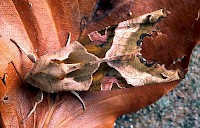
No.4 Angle Shades
About 1.5 inches long, has unusual 'crumpled' or folded wings at rest, evolved to provide excellent camouflage amongst dried leaves. Can be found at any time of year.
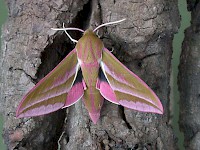
No.5 Elephant Hawk-moth
A wonderful pink and green species, with streamlined appearance and around 2.5 inches wingspan. Legs and antennae have whitish appearance.
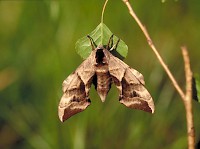
No.6 Eyed Hawk-moth
Normally well-camouflaged with subtle darker and lighter shades of brown, it rests in a strange position with hindwings held slightly forward. Has intense blue and pink eyes on hindwings, but these are not normally visible.
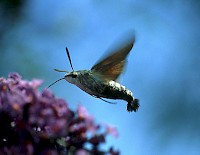
No.7 Hummingbird Hawk-moth
Looks like a hummingbird! - flies in the daytime and hovers in front of flowers, extending its proboscis to drink nectar. The orange-brown hindwings and black and white tail can be seen as it hovers.
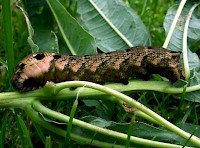
No.8 Elephant Hawk-moth Caterpillar
With a fanciful resemblance to an elephant's trunk, and up to 3 inches long, this caterpillar is velvety to the touch and has false 'eyes' which it displays when alarmed.
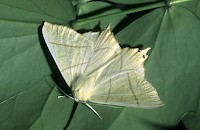
No.9 Swallow-tailed Moth
About 2 inches across the wings, with delicate yellowish or creamy paper-like appearance. Has distinct 'tails' on the hindwings with darker spots at the base. Once described as a 'Flying post-it note'! Normally only flying in mid to late July.
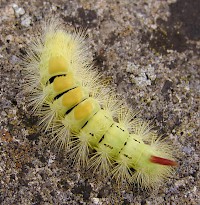
No.12 Pale Tussock Caterpillar
A very distinctive yellow hairy caterpillar, with four noticeable yellow tuftsalong the back and a brownish one extending from the rear end.
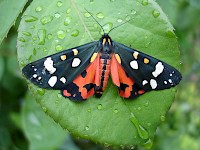
No.13 Scarlet Tiger
Quite a spectacular moth - bright orange hindwings with darker spots, and greenish black forewings with white and cream spots. Expanding its range northwards it can be found well into the Midlands.
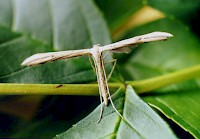
No.14 Emmelina monodactyla
A strange moth, which rests in a T-shape, with the wings rolled tightly around. About 1 inch in wingspan, it also has long spindly legs and is generally pale buff in colour.
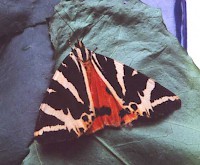
No.15 Jersey Tiger
Once a scarce south-western species, this brightly-coloured day-flying species is now found all over the south and south-west, and is becoming more and more noticed
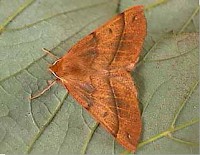
No.16 Feathered Thorn
Rich red-brown, resting in a distinctive triangular fashion. The antennae can look very white, but are sometimes held hidden beneath the wings. A late autumn species, usually in October and November.
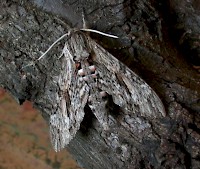
No.17 Convolvulus Hawk-moth
A large grey moth, wingspan about 4 inches. Quite a rare immigrant species, which can turn up anywhere in autumn, though more likely near the coast.
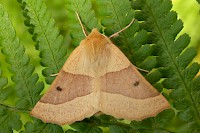
No.18 Scalloped Oak
About an inch across the wings, this two-tone buff moth appears in July and August. There is a darker band across the centre of the wings containing a brown spot.
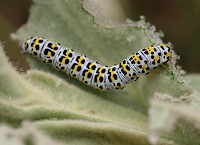
No.19 Mullein Caterpillar
A yellow, black and white caterpillar which is sometimes found in gardens, as it has a tendency to feed on Buddleia in addition to its normal foodplants.
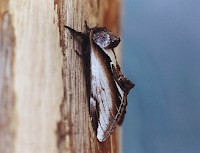
No.20 Lesser Swallow Prominent
A species which occurs in the spring as well as early autumn, this moth has a subtlecombination of chocolate brown and white colours, but is very similar to the Swallow Prominent

 UKMoths
UKMoths 